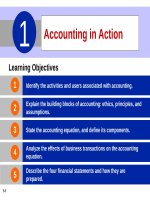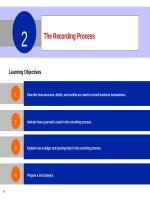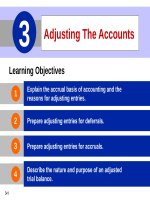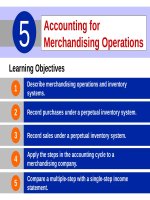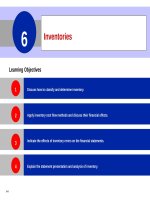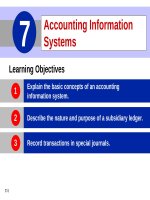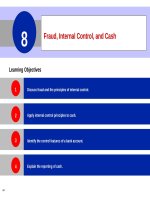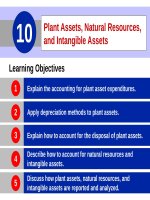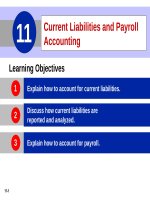Accounting principles 12th willey kieso chapter 10
Bạn đang xem bản rút gọn của tài liệu. Xem và tải ngay bản đầy đủ của tài liệu tại đây (1.48 MB, 81 trang )
10
Plant Assets, Natural Resources,
and Intangible Assets
Learning Objectives
10-1
1
Explain the accounting for plant asset expenditures.
2
Apply depreciation methods to plant assets.
3
Explain how to account for the disposal of plant assets.
4
Describe how to account for natural resources and
intangible assets.
5
Discuss how plant assets, natural resources, and
intangible assets are reported and analyzed.
LEARNING
OBJECTIVE
1
Explain the accounting for plant asset
expenditures.
Plant assets are resources that have
physical
substance (a definite size and shape),
are
used in the operations of a business,
are
not intended for sale to customers,
are
expected to be of use to the company for a number of
years.
Referred to as property, plant, and equipment; plant and
equipment; and fixed assets.
10-2
LO 1
Plant Assets
Plant assets are critical to a company’s success
Illustration 10-1
10-3
LO 1
Determining the Cost of Plant Assets
Historical Cost Principle requires that companies record
plant assets at cost.
Cost consists of all expenditures necessary to acquire
an asset and make it ready for its intended use.
10-4
LO 1
Determining the Cost of Plant Assets
LAND
All necessary costs incurred in making the land ready for
its intended use increase (debit) the Land account.
Costs typically include:
1.cash purchase price,
2.closing costs such as title and attorney’s fees,
3.real estate brokers’ commissions, and
4.accrued property taxes and other liens on the land
assumed by the purchaser.
10-5
LO 1
Determining the Cost of Plant Assets
Illustration: Hayes Company acquires real estate at a cash
cost of $100,000. The property contains an old warehouse that
is razed at a net cost of $6,000 ($7,500 in costs less $1,500
proceeds from salvaged materials). Additional expenditures are
the attorney’s fee, $1,000, and the real estate broker’s
commission, $8,000.
Required: Determine the amount to be reported as the cost of
the land.
10-6
LO 1
Determining the Cost of Plant Assets
Required: Determine amount to be reported as the cost of the
land.
Land
Cash price of property ($100,000)
$100,000
Net removal cost of warehouse ($7,500-$1,500)
6,000
Attorney's fees ($1,000)
1,000
Real estate broker’s commission ($8,000)
8,000
Cost of Land
$115,000
Illustration 10-2
Computation of cost of land
10-7
LO 1
Determining the Cost of Plant Assets
LAND IMPROVEMENTS
Structural additions made to land. Cost includes all
expenditures necessary to make the improvements ready
for their intended use.
Examples:
driveways, parking lots, fences, landscaping, and
underground sprinklers.
Limited
useful lives.
Expense
(depreciate) the cost of land improvements over
their useful lives.
10-8
LO 1
Determining the Cost of Plant Assets
BUILDINGS
Includes all costs related directly to purchase or construction.
Purchase costs:
Purchase
price, closing costs (attorney’s fees, title
insurance, etc.) and real estate broker’s commission.
Remodeling
and replacing or repairing the roof, floors,
electrical wiring, and plumbing.
Construction costs:
Contract
price plus payments for architects’ fees, building
permits, and excavation costs.
10-9
LO 1
Determining the Cost of Plant Assets
EQUIPMENT
Include all costs incurred in acquiring the equipment and
preparing it for use.
Costs typically include:
Cash
purchase price.
Sales
taxes.
Freight
charges.
Insurance
during transit paid by the purchaser.
Expenditures
required in assembling, installing, and testing
the unit.
10-10
LO 1
Determining the Cost of Plant Assets
Illustration: Lenard Company purchases a delivery truck at a
cash price of $22,000. Related expenditures are sales taxes
$1,320, painting and lettering $500, motor vehicle license $80,
and a three-year accident insurance policy $1,600. Compute
the cost of the delivery truck.
Truck
Cash price
$22,000
Sales taxes
1,320
Painting and lettering
Illustration 10-4
Computation of cost of
delivery truck
10-11
Cost of Delivery Truck
500
$23,820
LO 1
Determining the Cost of Plant Assets
Illustration: Lenard Company purchases a delivery truck at a
cash price of $22,000. Related expenditures are sales taxes
$1,320, painting and lettering $500, motor vehicle license $80,
and a three-year accident insurance policy $1,600. Prepare the
journal entry to record these costs.
Equipment
23,820
License Expense
80
Prepaid Insurance
1,600
Cash
25,500
10-12
LO 1
Expenditures During Useful Life
Ordinary Repairs are expenditures to maintain the operating
efficiency and productive life of the unit.
Debit
to Maintenance and Repair Expense.
Referred
to as revenue expenditures.
Additions and Improvements are costs incurred to
increase the operating efficiency, productive capacity, or
useful life of a plant asset.
Debit
the plant asset affected.
Referred
10-13
to as capital expenditures.
LO 1
ANATOMY OF A FRAUD
Bernie Ebers was the founder and CEO of the phone company WorldCom. The
company engaged in a series of increasingly large, debt-financed acquisitions of other
companies. These acquisitions made the company grow quickly, which made the stock price
increase dramatically. However, because the acquired companies all had different accounting
systems, WorldCom’s financial records were a mess. When WorldCom’s performance started
to flatten out, Bernie coerced WorldCom’s accountants to engage in a number of fraudulent
activities to make net income look better than it really was and thus prop up the stock price.
One of these frauds involved treating $7 billion of line costs as capital expenditures. The line
costs, which were rental fees paid to other phone companies to use their phone lines, had
always been properly expensed in previous years. Capitalization delayed expense recognition
to future periods and thus boosted current-period profits.
Total take: $7 billion
THE MISSING CONTROLS
Documentation procedures. The company’s accounting system was a disorganized collection
of non-integrated systems, which resulted from a series of corporate acquisitions. Top
management took advantage of this disorganization to conceal its fraudulent activities.
Independent internal verification. A fraud of this size should have been detected by a routine
comparison of the actual physical assets with the list of physical assets shown in the accounting
records.
10-14
LO 1
10-15
LO 1
DO IT! 1
Cost of Plant Assets
Assume that Drummond Heating and Cooling Co. purchases a
delivery truck for $15,000 cash, plus sales taxes of $900 and
delivery costs of $500. The buyer also pays $200 for painting
and lettering, $600 for an annual insurance policy, and $80 for
a motor vehicle license. Explain how each of these costs would
be accounted for.
Solution
10-16
The first four payments ($15,000, $900, $500, and $200)
are include in the cost of the truck ($16,600).
The payments for insurance and the license are
operating costs and therefore are expensed.
LO 1
LEARNING
OBJECTIVE
2
Apply depreciation methods to plant
assets.
Depreciation
Process of allocating to expense the cost of a plant asset
over its useful (service) life in a rational and systematic
manner.
Process
of cost allocation, not asset valuation.
Applies
to land improvements, buildings, and equipment,
not land.
Depreciable
because the revenue-producing ability of
asset will decline over the asset’s useful life.
10-17
LO 2
Factors in Computing Depreciation
Illustration 10-6
Three factors in computing
depreciation
Alternative Terminology
Another term sometimes used for
salvage value is residual value.
10-18
Helpful Hint
Depreciation expense is reported on
the income statement. Accumulated
depreciation is reported on the balance
sheet as a deduction from plant assets.
LO 2
Depreciation Methods
Management selects the method it believes best measures
an asset’s contribution to revenue over its useful life.
Examples include:
1.Straight-line method
2.Units-of-activity method
3.Declining-balance method
Illustration 10-8
Use of depreciation methods
in major U.S. companies
10-19
LO 2
Depreciation Methods
Illustration: Barb’s Florists purchased a small delivery truck on
January 1, 2017.
Illustration 10-7
Delivery truck data
Cost
$13,000
Expected salvage value
$1,000
Estimated useful life in years
5
Estimated useful life in miles
100,000
Required: Compute depreciation using the following.
(a) Straight-Line (b) Units-of-Activity (c) Declining Balance
10-20
LO 2
Depreciation Methods
STRAIGHT-LINE METHOD
Expense
is same amount for each year.
Depreciable
cost = Cost less salvage value.
Illustration 10-9
Formula for straight-line
method
10-21
LO 2
Depreciation Methods
Illustration: (Straight-Line)
Illustration 10-10
2017
$ 12,000
2018
12,000
2019
12,000
2020
12,000
2021
12,000
20%
20
20
20
$ 2,400
$ 2,400
$ 10,600 *
2,400
4,800
8,200
2,400
7,200
5,800
2,400
9,600
3,400
2,400
12,000
1,000
20
2017
Journal
Entry
10-22
Depreciation expense
2,400
Accumulated depreciation
* Book value = Cost - Accumulated depreciation = ($13,000 - $2,400).
2,400
LO 2
Depreciation Methods
Partial
Year
Illustration: (Straight-Line)
Assume the delivery truck was purchased on April 1, 2017.
10-23
LO 2
DO IT! 2
Straight-Line Depreciation
On January 1, 2017, Iron Mountain Ski Corporation purchased a
new snow-grooming machine for $50,000. The machine is
estimated to have a 10-year life with a $2,000 salvage value.
What journal entry would Iron Mountain Ski Corporation make at
December 31, 2017, if it uses the straight-line method of
depreciation?
Solution
Depreciation expense
depreciation
($50,000 - $2,000) ÷ 10 = $4,800
10-24
4,800
Accumulated
4,800
LO 2
Depreciation Methods
UNITS-OF-ACTIVITY METHOD
Companies
estimate total units of activity to calculate
depreciation cost per unit.
Expense
varies based on units of activity.
Depreciable
cost is cost less salvage value.
Alternative Terminology
Another term often used
is the units-of-production
method.
10-25
LO 2

